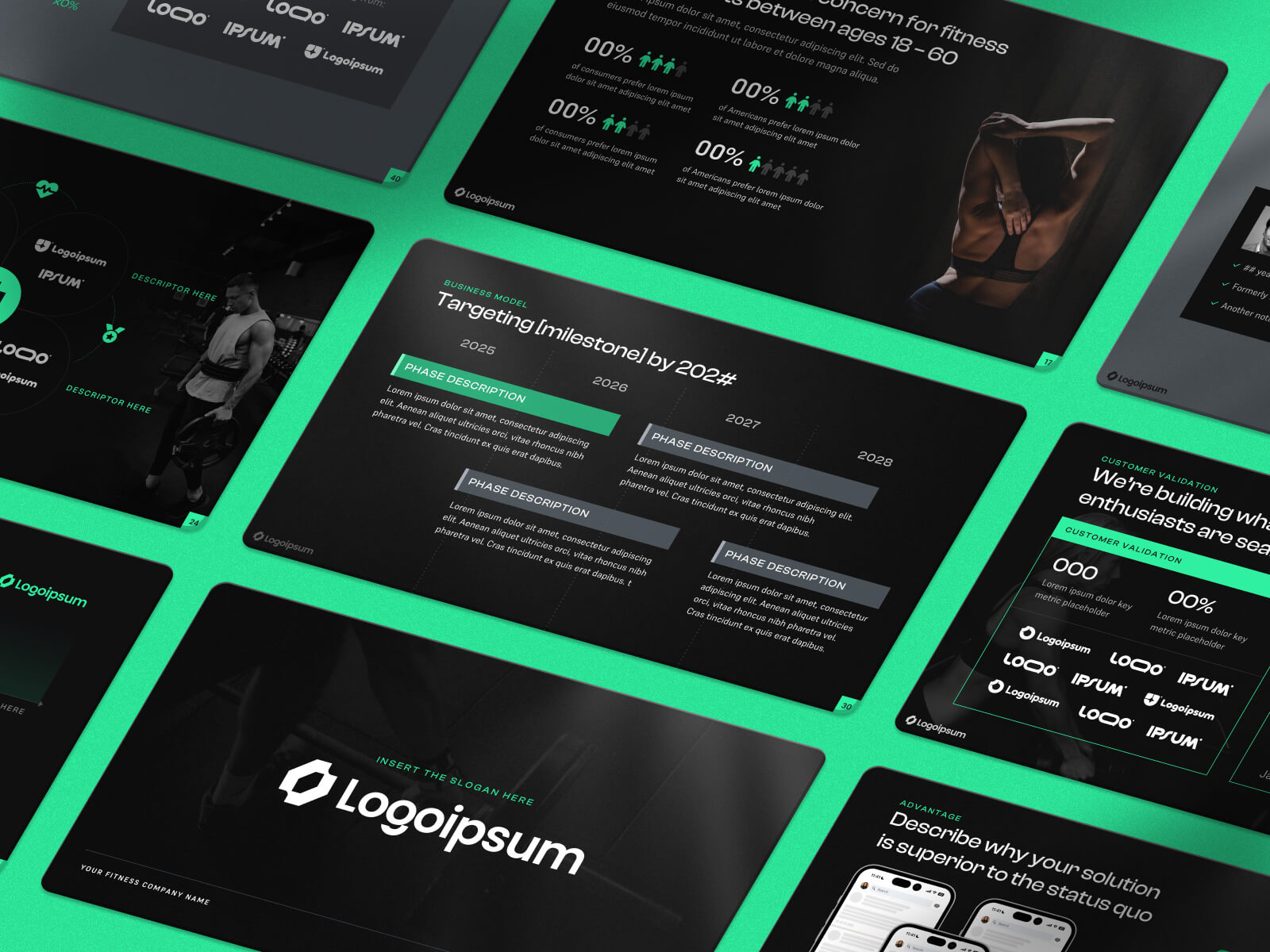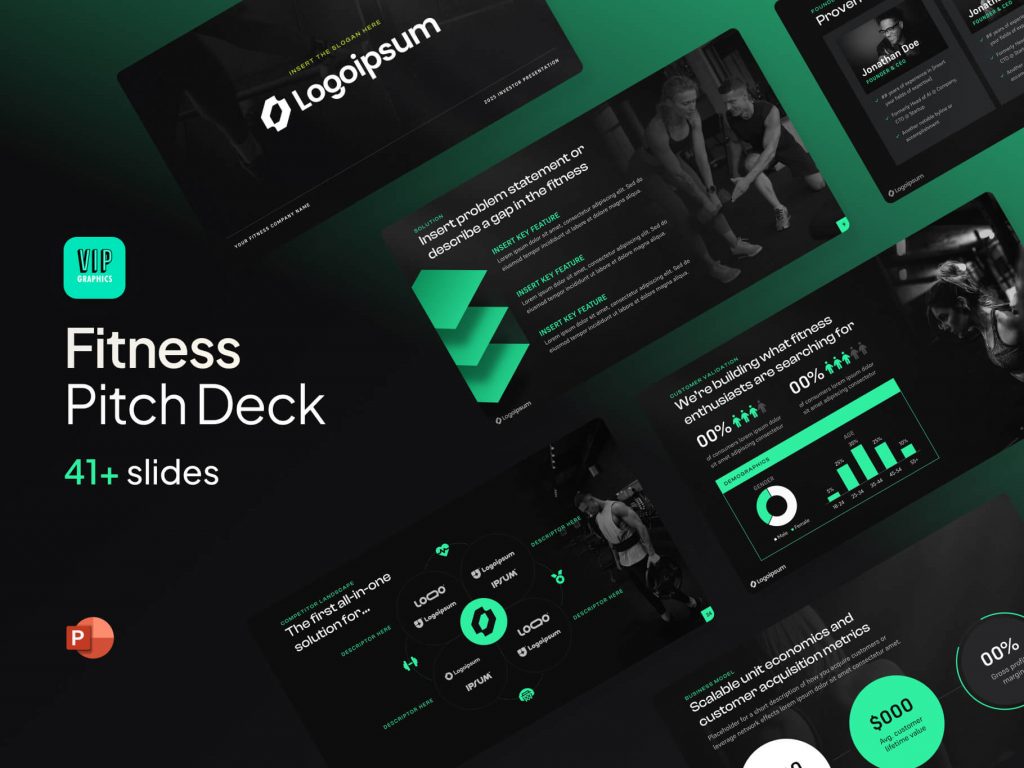Fitness is a virtually evergreen opportunity for innovation: humans will always be looking for ways to improve their exercise, nutrition, and overall wellness. For instance, today the advent of smart fitness technology and personalized nutrition promises to advance the industry further that goal. VC funds invest more than a billion dollars annually in fitness and wellness startups (~$1.4B annually for the last two years). Despite this, competing in the fitness industry can be tough and unforgiving — just ask Peloton (whose first pitch deck you can see here, by the way). Winning investor backing for your fitness company starts with your pitch deck:
What is a pitch deck? What is its purpose?
Pitch decks are presentations that businesses use to secure critical partnerships with investors, customers, and sponsors. In this case, we’ll be talking about investor pitch decks, which are for raising funding (although there are other kinds of decks, such as retail distribution decks and sponsorship decks, which many consumer-facing fitness companies will also need).
An effective pitch deck should communicate your startup’s vision and mission, highlight the problem you’re focused on, and why you’re uniquely positioned to build the right solution.
What slides should be in your fitness pitch deck?
Here’s a breakdown of the essential slides that belong in every fitness pitch deck, whether you’re developing smart at-home fitness tech or growing a brick-and-mortar gym:
Cover Slide
In every presentation, your cover slide is your first impression, so don’t let it be an afterthought. It’s important to maintain consistent branding throughout your presentation, and that starts with including your logo, your brand fonts and colors, and any relevant imagery. It’s a good idea to include a tagline that captures what you do here, to orient the reader for the rest of the deck. Carefully select the right imagery to feature on your cover slide. For example: a fitness app might show screenshots of the user experience, whereas a gym might use a large background photo of their facility.
Problem
Any “investable” startup should target a critical problem that affects a large population or fill an unserved gap in the fitness market. Institutional investors are typically looking for startups that can scale to billions in revenue (or a sizable exit), so your problem slide should reflect that. You’ll want to cite statistics and quotes from notable sources to back up your claims. Be sure to not only mention the problem itself, but also illustrate the impact and why it matters. While numbers are powerful, relatable stories (ie. the company / founder’s origin story) can also help build a relatable narrative.
Solution
Having previously introduced the problem, the next slide in your pitch deck should explain how you company uniquely solves this. It’s important not just to talk about features or offerings here, and focus more on the core value proposition (that is, what your customers get out of this). This same philosophy applies when you’re talking to customers: talk about the benefits, not the features.
How It Works
For certain companies (ie. fitness tech and equipment such as wearables), including a separate slide explaining how the product works will be necessary. Using diagrams, photos, and conceptual graphics will help visually communicate your point here. Some founders opt to include a short video, but this can be a double-edged sword (read more here).
Competition Slide
Investors will want to know what makes your solution unique. The competition slide should highlight the features and benefits that set you apart from competitors and existing solutions.
If you’re building new fitness technology in an unexplored market, you might think that you don’t have any competitors, but that’s not true. If there is demand for your product, chances are customers are using some kind of low-tech or hacked together solution already. Every startup has competition; not having a competition slide will be a red flag to investors, so don’t skip it.
On the other hand, if you’re raising funding for a gym, this slide will look a little different with a “competitive set” listing nearby gyms and fitness studios in the local market, with an overview of their shortcomings and locations.
Regardless of what you’re raising funding for, investors will want to see that you have a thorough knowledge of the existing competitive landscape and a concrete plan for winning against new entrants and incumbents.
Advantage Slide
The advantage slide might seem redundant with the competition slide at first, but it describes something slightly different. Essentially, the competition slide says why you’re better for customers, whereas advantage says why you’re the right investment. For example, you might cite proprietary technology and patnets that prevent copycats or partnerships with marquee organizations to accelerate your go-to-market.
Market/Opportunity
The market slide is arguably one of the most important in a deck because it can make or break an investment pitch. Institutional investors will not be interested in a company that addresses a market too small to ever possibly generate the ROI they are looking for.
The biggest mistake on this slide is to cite generic market figures, such as the entire fitness industry size. For example, if you’re building a nutrition app, citing the entire nutrition market (which includes several segments beyond apps) is a bad move.
Your market analysis should demonstrate you’ve given thought to quantifying the potential demand for your specific product. Moreover, you shouldn’t focus solely on market sizing, but also on trend data to show growth in the market and why now is the right time to build this.
Target Users
There are two different ways to present who your company serves in the target users slide. Some companies will break out their customers into groups or use cases and describe the benefits they offer to each one of those groups, whereas others, especially those that already have an active customer base, will talk about the demographics and preferences of their existing user base and how they plan to expand. This is a good place to touch upon some of your go-to-market and customer acquisition strategies and why your product is the right solution for your target users’ needs.
Traction
The traction slide is effectively your chance to brag in the pitch dec: talk about everything you’ve accomplished so far. Tractiondoesn’t necessarily have to be monetary or user growth at the very early stages. While you’ll definitely want to mention the number of customers (or waitlists for pre-launch companies), revenue, and any notable logos, underlying milestones like patents for your technology, partnerships, and even press coverage are worth mentioning.
The overally intention of this slide is to demonstrate validation that you’re moving towards product-market fit and people truly like what you’re building.
Business Model
As one would expect, investors want to know how you make money, and the business model slide answers that. Sometimes, this can be as simple as a pricing table breaking out your plans or features, or different revenue streams. Other companies, especially those that are already generating revenue, will include a breakdown of where their revenue is coming from and unit economics like customer acquisition costs and profit margins.
If you’re pre-revenue, remember that although revenue diversification is a good thing, too many revenue streams can be a red flag. Investors want to see that you’re focused. A common Silicon Valley adage is that the key to a winning startup is to “do one thing right,” though Rippling’s compound startup model stands as a counter-proof.
Team
Many startups will end up pivoting several times after raising funding. As such, an investment in a startup is at the early stages is an investment in its people. The team slide should introduce why you are the right people to build this company. Mention your relevant background, both in terms of business track record and academic qualifications, as well as anything else that speaks to your understanding of the market and product development capabilities. For solo founders in early stage startups, this might be more of an “About the founder” slide, with a list of some near-term hires.
Investment
Finally, no investor pitch deck is complete without an ask slide, which lays out how much funding you’re raising and how you’ll use that capital. Some companies will keep this incredibly simple and just talk about the northstar milestone (ie. revenue or user target, profitability) they aim to achieve and the target date for the next raise. Others will include a deeper breakdown of the use of funds and/or some of the top-level milestones.
Roadmap
The roadmap slide should paint a vivid picture of your company’s path to profitability and vision for the future. Here, you want to talk about not only what you’re going to achieve with the funding you’re raising now, but where you aim to go after that. For instance, if you’re raising for 18 months of runway, you might breakdown the target milestones in 6-month phases, followed by a long-term roadmap over the next few years.
Ready to create your fitness startup or gym’s pitch deck?
Check out our Fitness Pitch Deck Template, created by experts who have helped countless smart fitness and nutrition startups as well as brick-and-mortar gyms and fitness studios to raise funding. Our team has tailored this template to the fitness industry, with our best practices for baked into each slide! Get a jumpstart on your fundraise with this professional-grade investor presentation tempalte for PowerPoint:

